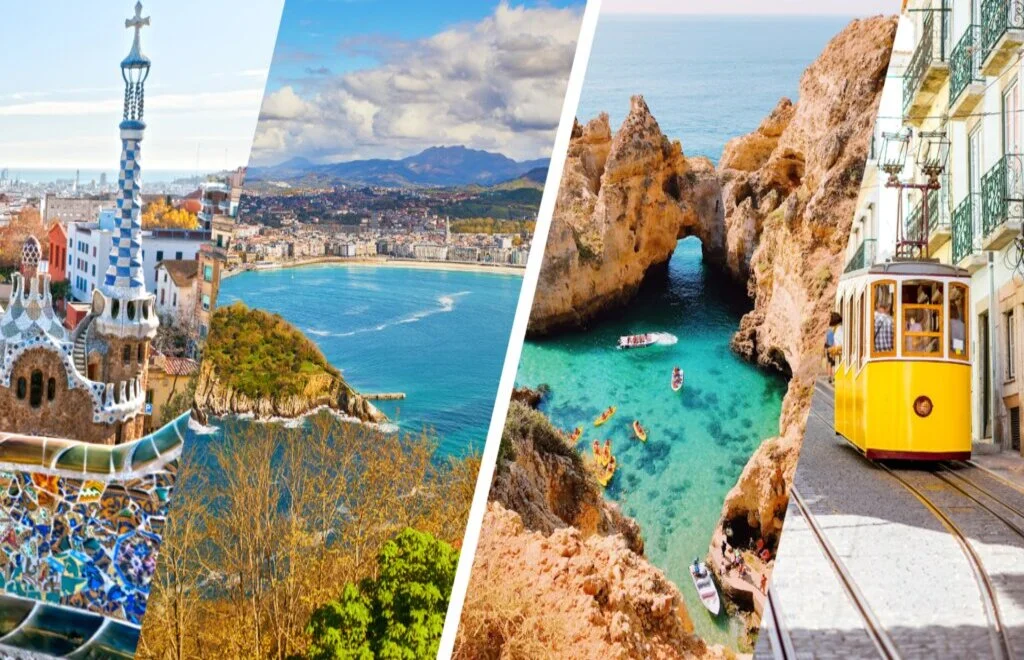Spain and Portugal are both incredibly beautiful places that are worth visiting and even better for backpacking.
However, if you only have a week to visit both the countries, there are only so many places you can visit to get the most out of both.
Ideally, plan a visit around march through mayor September through October to experience the best weather.
Stick to the highlights of the tourist attractions which give you the most consolidated perspective into the cultures and even enjoy the best foods they have to offer. Transport being a major factor in any travel scenario is something that you won’t need to worry too much about in Spain.
The cities have well-developed public transportation in the form of metros, subways and taxis. Uber is available in all major cities. In Portugal, it’s much easier to travel short distances by tuk-tuk and long distances can be covered by trains. With that being said, here a plan for the trip to Spain and Portugal.
Day 1 & 2 Barcelona
Barcelona, a stunning seaside city and the capital of autonomous Catalonia, is a hot spot for tourists with millions flying into the city to enjoy its beautiful beaches, incredible architecture, cultural attractions, gorgeous scenery and an awesome party scene. Its Mediterranean climate, old-world ambience and modernist architecture give the city a quaint charm while some of its sophisticated buildings are even UNESCO listed.
While there are dozens of must-see things in the city, these ones must be on your list on the trip to Spain.
1. Park Guell
One of the coolest works of art you will come across on the trip to Spain is Antoni Gaudi’s unfinished housing project which was eventually turned into a city park and tourist attraction.
Park Guell which is a UNESCO World Heritage Site started out as a housing community for Barcelona’s elite in 1900 and only after the construction of 2 out of the planned 60 houses, the public interest waned and funding stopped. It was eventually bought by the city and turned into a public park.
There are three main entrances to the park and the most frequently used is the one along Carrer d’Olot which gives the best view of the park. The entrance from Plaça de la Natura, however, is a lot less crowded and a fine place to begin your tour.
The tickets cost 13€ (adults) and 9.50€ (children 7 to 12 and seniors). Tickets can be bought three months in advance as they get sold out quite quickly.
Getting to the park is a bit of a trek from the city and the metro is the best way to start. Get off on the Vallarta Station on the Green Line (L3) and hike up the hill. On the way, you will also find escalators which will come quite in handy if you are low on energy.

2. Sagrada Familia
Considered Antoni Gaudi’s greatest masterpiece, the Sagrada Familia Church should definitely be a stop on the trip to Spain to marvel at its intricate architecture and grandiosity. Surprisingly the church still remains unfinished nearly a hundred years after the death of its architect. Despite being incomplete, it remains Barcelona’s most visited tourist attraction with 3 million tourists pouring in every year.
Gaudi himself was aware that the church would take decades to build and he wouldn’t see it in his lifetime and it won’t be his creation entirely.
This is reflected in the personal touches and deviation of many others who have come in the subsequent generations.
The highlights include the Nativity facade which was supervised by Gaudi himself, the Passion facade which depicts the final days of Christ, the Escoles de Gaudí just opposite to the Passion facade which is another architectural gem. While you’re here you also need to visit the museum in the church’s basement that honours Gaudi who has had such an influence on the city.
The Sagrada Familia church is located at a walking distance north of the bustling Avinguda Diagonal. You can also take the metro lines 2 and 5 to get off at the Sagrada Familia where even a number of busses make a stop. Entry ticket with Audio Guide costs €33.80, tickets with guided tour cost €47.00.
The church opens at 9:00 am every day and the closing times can vary depending on specific days and months.

3. Dining: Paellería Gaudí, Paella, Sangria!
Paella and Sangria are the two of the popular food combination you need to try on the trip to Spain. Paella is a unique dish made out of rice, clams, shrimps ancient roots and spices and an absolute delicacy to the locals and tourists looking for a taste of the Mediterranean.
While there’s really no original recipe for the dish, many of the ingredients remain common and the tastes vary with the different ways in which it is prepared with seasonal vegetables and twists in the ingredients.
To go with the dish is the popular Spanish drink Sangria which is an alcoholic punch made out of red wine, chopped fruit and mixed with a range of other drinks including brandy and even orange juice!
While it is popularly available across the whole city, one of the best places to try it out in the city is Paellería Gaudí which serves a range of Spanish fare and specializes in paellas and tapas.
The restaurant serves a range of paellas and tapas with unique ingredients from different parts of the country. It is located on : C/ de Provença, 271, L’Eixample, 08008 Barcelona, Spain, open from 11:00 am to 00:00 am, you can call for reserving a table +(34) 932 15 32 37.

Day 3 & 4 Madrid
Madrid is a sprawling city that’s jam-packed with people, visitors and cultural attractions that’s quite different from other cites and attractions on the trip to Spain. Although it is a bit on the congested side its beautiful parks offer a nice break between the urban sprawl. The city is often bustling with tourists and there are plenty of sights too, places to eat and night clubs to drink and party.
4. Madrid Palace
Although this isn’t where Spain’s royal family lives anymore, the palace’s historic and incredible architecture is sure to blow your mind. The Madrid Palace was reconstructed in 1734 after the original one burned to the ground and it is a place for important state events and ceremonies.
The palace contains an astounding 3000 rooms out of which only a few are open to visitors. Some of the must-see things are the sweeping main staircase which is one of the few places for a photo op for the tourists. The Hall of Columns where royal and state meets take place is the other place you need to explore and the stately dining room and the royal chapel are sure to amaze you.
If you wish to skip the line, you can book tickets online. The English guided tour costs $32 and lasts 2 hour. There are a number of other tours that cost different and include other places.

5. San Miguel Market
Enthusiasts of Mediterranean fare will find the San Miguel Market to be a heaven on the trip to Spain. Established in 1916, this old market with is the centre place for all foods and ingredients from around the country was renovated and reopened in 2009.
Located right in the heart of the city, the market is popular among both the locals and tourists for being a gourmet tapas market. It gets over 10 million visitors a year who flock in to experience the modern essence of Spanish fare from all corners of the country.
The market has over 30 vendors who sell a wide range of freshly prepared taps, baked items, hams, olives and even fine spirits such as champagne and whisky. You will also find plenty of fresh seafood from Galicia, special cheese from Castile and different types of rice from the Mediterranean.
If you’re looking for one place to find everything that’s in the Spanish fare then the San Miguel Market is the place to go. It is open from Sunday to Thursday from 10:00 am – Midnight. Weekends and eve of public holidays; 10:00 am to 01:00 am. To get to the market take the Metro L2, L5 and R to the Opera station and walk to the market following directions.

6. Dining: Seafood & Tapas, La Mallorquina!
One thing that you need to remember on the trip to Spain is that tapas is not a type of dish. Technically tapa or tapas (English) is a small portion of any type of Spanish cuisine. Served all across the country, they come in nearly infinite varieties and can be cold; mixed with olives and cheese or even hot such as friend seafood.
Tapas have turned out to be more sophisticated over the years and every restaurant or diner can have their own signature variety of it. So on your travelling in Spain, be sure to order tapas to experience all the varieties possible.
The La Mallorquina located at a street corner in Puerta del Sol on Calle Mayor is one of the oldest pastry shops in Madrid and hence a popular tourist spot along with being an icon in the city. It has been in business since 1894 and features two levels; one at the street and one above. While you can buy on the ground floor, experience in the tea room above is highly recommended.

Day 5 & 6 Lisbon
Lisbon inevitably falls on the itinerary of the trip to Spain and Portugal for every traveller exploring this region. A beautiful holiday destination, the city offers a rich depth in history which is blended with modern architecture and an amazing nightlife all under perfect weather throughout the year.
7. Arco da Rua Augusta & Castelo de S. Jorge
The Arco da Rua Augusta or the triumphal arch built to commemorate a devastating 1755 earthquake in the city stands 11m tall. Symbolizing the strength, resilience and achievement of the Portuguese people, the monumental gate is a symbol of the country’s pride and a major tourist attraction. Standing like a gateway from the Tagus river, the structure is a great entry point into the city from the port. The Clock Room at the attraction offers visitors a history of this structure and is open from 9 am to 8 pm.
Admission for children under 5 is free and for adults is 4,50€.

Moving further ahead you will come across the Castelo de S. Jorge or the St. George’s Castle which is one of the most popular tourist attractions in the city. Sitting on top of a hill the castle near Alfama, it overlooks the capital and offers splendid panoramic views from its observation terraces of the surrounding city, the Tagus River and the Atlantic Ocean at a distance. The castle is open from 9 am to 9 pm between March to October and 9 am to 6 pm between Novembers to February.
Admission tickets are 19.00€ (adults), and free for children under 10 years.

8. Padrao dos Descobrimentos
Padrao dos Descobrimentos (Monument of the Discoveries) is an imposing limestone structure erected in 1960 on the banks of the Tejo Estuary of the Tagus River. It stands primarily as a monument of the spirit of exploration of the Portuguese visionaries who had the nation established as one of the most powerful seafaring nation of the era.
It was also meant to commemorate the death of Prince Henry, the poet Luís de Camões and Vasco da Gama the navigator. The monument is a replica of the original one built temporarily in the 1940s during the Portuguese World Exhibition where the five continents where the Portuguese people set foot were represented.

9. Dining: Pasteis de Belem
While you are on the trip to Spain and Portugal, one stop you need to make is at the Pasteis de Belem– meaning Cake of Belem. Being one of the most reviewed eateries in the world, it was established in 1837 and is popular for its pastries which cost as little as € 1.10 on an average. While the pastries cost less, they are also excellent in taste and quality and you will have to wait in long queues to get your chance at trying one out!
Their recipe has mostly remained unchanged since they opened and adds to the charm of this establishment which spans nearly two centuries.
When you arrive to them location you will mostly find people ordering take-aways. You can also choose to sit in one of the several cafes and enjoy their full range of offerings.
There is even a large window which gives you an interesting peek into the kitchen where you can see how these delicacies are made.

Day 7 Cabo da Roca
On the last day of the trip to Spain and Portugal you definitely need to visit Cabo da Roca, a point which was in ancient times considered as the end of the world!
At a distance of 45km, Cabo da Roca is about an hour’s drive from Lisbon. Renting your own car is a great way to enjoy your trip along the way. You can also take the bus 403 which shuttles between Sintra and Cascais and makes at stop at Cabo da Roca. The journey is about 30 minutes from either place.
Spain and Portugal are both Mediterranean paradises with a quaint charm that attracts millions of travellers from around the world. Whether you’re travelling for business or leisure, or with your family or a solo trip, there are infinitely great sights and experiences to try out in both the countries. And while you book your flight tickets with us, ensure to choose the best hotels along with it to get cheap deals and the best services on your travel. Book some of the coolest places to stay close to where all the fun is and plan the best trip on your visit to Spain.

The World Is Huge. Don’t Miss Any Of It























